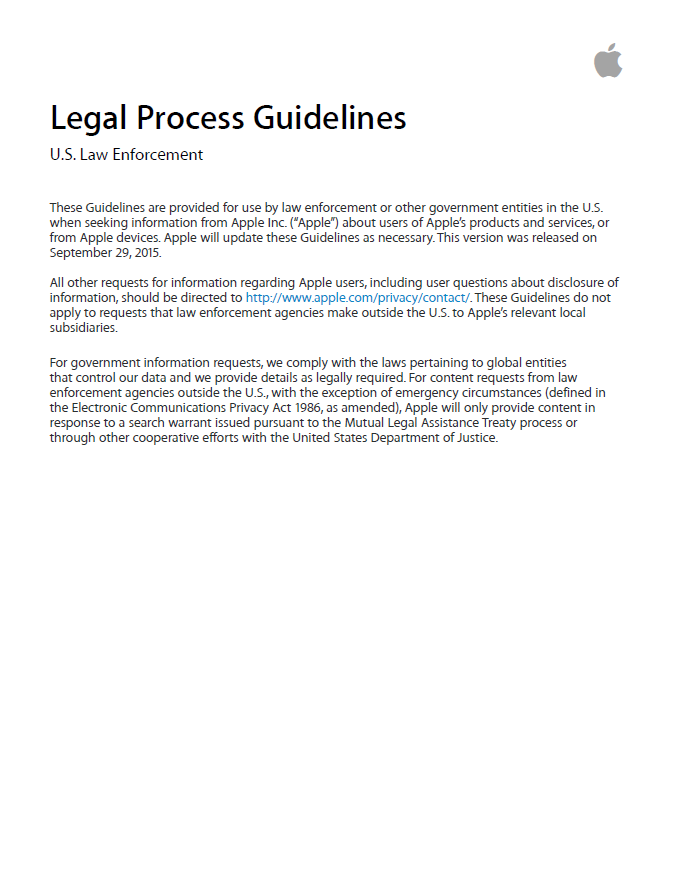These Guidelines are provided for use by law enforcement or other government entities in the U.S. when seeking information from Apple Inc. (“Apple”) about users of Apple’s products and services, or from Apple devices. Apple will update these Guidelines as necessary. This version was released on September 29, 2015.
All other requests for information regarding Apple users, including user questions about disclosure of information, should be directed to http://www.apple.com/privacy/contact/. These Guidelines do not apply to requests that law enforcement agencies make outside the U.S. to Apple’s relevant local subsidiaries.
For government information requests, we comply with the laws pertaining to global entities that control our data and we provide details as legally required. For content requests from law enforcement agencies outside the U.S., with the exception of emergency circumstances (defined in the Electronic Communications Privacy Act 1986, as amended), Apple will only provide content in response to a search warrant issued pursuant to the Mutual Legal Assistance Treaty process or through other cooperative efforts with the United States Department of Justice.
…
III. Information Available From Apple
A. Device Registration
Basic registration or customer information, including, name, address, email address, and telephone number is provided to Apple by customers when registering an Apple device prior to iOS 8 and OS Yosemite 10.10. Apple does not verify this information, and it may not be accurate or reflect the device’s owner. Registration information for devices running iOS 8 and later versions, as well as Macs running OS Yosemite 10.10 and later versions is received when a customer associates a device to an iCloud Apple ID. This information may not be accurate or reflect the device’s owner. Registration information can be obtained with a subpoena or greater legal process.
Please note, Apple device serial numbers do not contain the letters “O” or “I,” rather Apple utilizes the numbers 0 (zero) and 1 (one) in serial numbers. Requests for serial numbers with either the letter “O” or “I” will yield no results.
…
G. iCloud
iCloud is Apple’s cloud service that allows users to access their music, photos, documents, and more from all their devices. iCloud also enables subscribers to back up their iOS devices to iCloud. With the iCloud service, subscribers can set up an iCloud.com email account. iCloud email domains can be @icloud.com, @me.com2 and @mac.com. All iCloud content data stored by Apple is encrypted at the location of the server. When third-party vendors are used to store data, Apple never gives them the keys. Apple retains the encryption keys in its U.S. data centers.
iCloud is a subscriber based service. Requests for iCloud data must include the relevant Apple ID/account email address. If Apple ID/account email address are unknown, Apple requires subscriber information in the form of full name and phone number, and/or full name and physical address to identify the subject Apple account.
The following information may be available from iCloud:
i. Subscriber Information
When a customer sets up an iCloud account, basic subscriber information such as name, physical address, email address, and telephone number may be provided to Apple. Additionally, information regarding iCloud feature connections may also be available. iCloud subscriber information and connection logs with IP addresses can be obtained with a subpoena or greater legal process. Connection logs are retained up to 30 days.
ii. Mail Logs
Mail logs include records of incoming and outgoing communications such as time, date, sender email addresses, and recipient email addresses. Mail logs may be obtained with a court order under 18 U.S.C. § 2703(d) or a court order with an equivalent legal standard or a search warrant. iCloud mail logs are retained up to 60 days.
iii. Email Content
iCloud only stores the email a subscriber has elected to maintain in the account while the subscriber’s account remains active. Apple does not retain deleted content once it is cleared from Apple’s servers. Apple is unable to provide deleted content. Available email content may be provided in response to a search warrant issued upon a showing of probable cause.
iv. Other iCloud Content. Photo Stream, Docs, Contacts, Calendars, Bookmarks, iOS Device Backups
iCloud only stores content for the services that the subscriber has elected to maintain in the account while the subscriber’s account remains active. Apple does not retain deleted content once it is cleared from Apple’s servers. iCloud content may include stored photos, documents, contacts, calendars, bookmarks and iOS device backups. iOS device backups may include photos and videos in the users’ camera roll, device settings, app data, iMessage, SMS, and MMS messages and voicemail. iCloud content may be provided in response to a search warrant issued upon a showing of probable cause.
H. Find My iPhone
Find My iPhone is a user-enabled feature by which an iCloud subscriber is able to locate his/her lost or misplaced iPhone, iPad, iPod touch or Mac and/or take certain actions, including putting the device in lost mode, locking or wiping the device. More information about this service can be found at http://www.apple.com/icloud/find-my-iphone.html. Location information for a device located through the Find My iPhone feature is user facing and Apple does not have records of maps or email alerts provided through the service. Find My iPhone connection logs may be available and can be obtained with a subpoena or greater legal process. Find My iPhone connection logs are available for a period of approximately 30 days. Find My iPhone transactional activity for requests to remotely lock or erase a device may be available with an order under 18 U.S.C. § 2703(d) or a court order with the equivalent legal standard or a search warrant.
Apple cannot activate this feature on users’ devices upon a request from law enforcement. The Find My iPhone feature must have been previously enabled by the user for that specific device. Apple does not have GPS information for a specific device or user.

